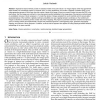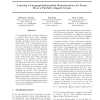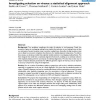1149 search results - page 3 / 230 » Learning to Align: A Statistical Approach |
EMNLP
2009
13 years 3 months ago
2009
Current statistical machine translation systems usually extract rules from bilingual corpora annotated with 1-best alignments. They are prone to learn noisy rules due to alignment...
PAMI
2006
13 years 5 months ago
2006
Appearance-based methods, based on statistical models of the pixel values in an image (region) rather than geometrical object models, are increasingly popular in computer vision. I...
ICML
1998
IEEE
14 years 6 months ago
1998
IEEE
Cross-language latent semantic indexing is a method that learns useful languageindependent vector representations of terms through a statistical analysis of a documentaligned text...
BMCBI
2008
13 years 5 months ago
2008
Background: Two problems complicate the study of selection in viral genomes: Firstly, the presence of genes in overlapping reading frames implies that selection in one reading fra...
EMNLP
2007
13 years 6 months ago
2007
We present a method for improving word alignment for statistical syntax-based machine translation that employs a syntactically informed alignment model closer to the translation m...



